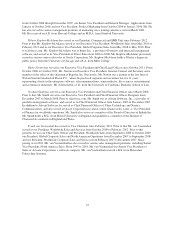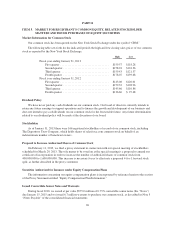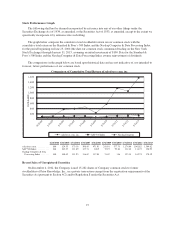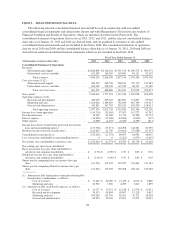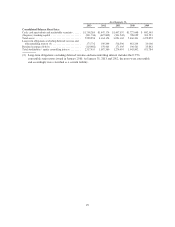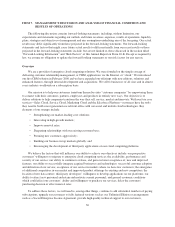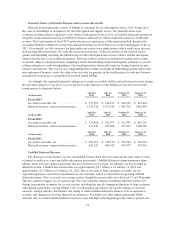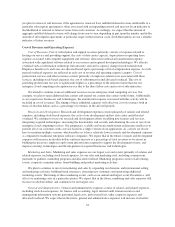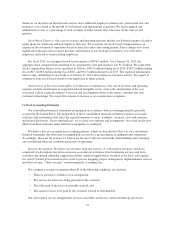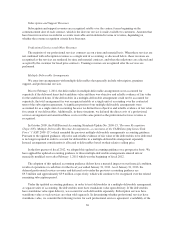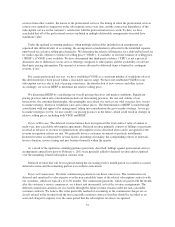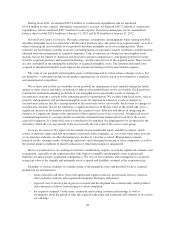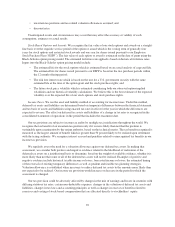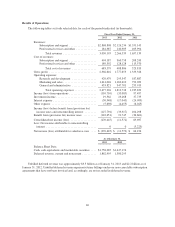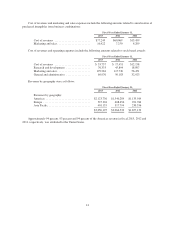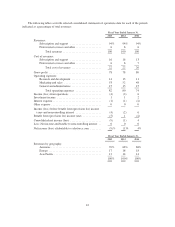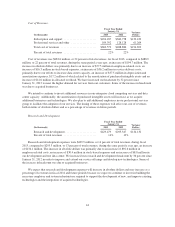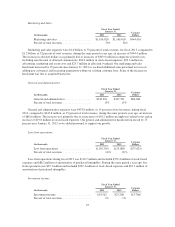Salesforce.com 2013 Annual Report Download - page 39
Download and view the complete annual report
Please find page 39 of the 2013 Salesforce.com annual report below. You can navigate through the pages in the report by either clicking on the pages listed below, or by using the keyword search tool below to find specific information within the annual report.dollars as we invest in our infrastructure and we incur additional employee related costs, professional fees and
insurance costs related to the growth of our business and international expansion. We expect general and
administrative costs as a percentage of total revenues to either remain flat or decrease for the next several
quarters.
Stock-Based Expenses. Our cost of revenues and operating expenses include stock-based expenses related to
equity plans for employees and non-employee directors. We recognize our stock-based compensation as an
expense in the statement of operations based on their fair values and vesting periods. These charges have been
significant in the past and we expect that they will increase as our stock price increases, as we hire more
employees and seek to retain existing employees.
For fiscal 2013, we recognized stock-based expense of $379.4 million. As of January 31, 2013, the
aggregate stock compensation remaining to be amortized to costs and expenses was $1.2 billion. We expect this
stock compensation balance to be amortized as follows: $491.0 million during fiscal 2014; $394.2 million during
fiscal 2015; $249.8 million during fiscal 2016; and $92.5 million during fiscal 2017. The expected amortization
reflects only outstanding stock awards as of January 31, 2013 and assumes no forfeiture activity. We expect to
continue to issue stock-based awards to our employees in future periods.
Amortization of Purchased Intangibles from Business Combinations. Our cost of revenues and operating
expenses include amortization of acquisition-related intangible assets, such as the amortization of the cost
associated with an acquired company’s research and development efforts, trade names, customer lists and
customer relationships. We expect this expense to increase as we acquire more companies.
Critical Accounting Estimates
Our consolidated financial statements are prepared in accordance with accounting principles generally
accepted in the United States. The preparation of these consolidated financial statements requires us to make
estimates and assumptions that affect the reported amounts of assets, liabilities, revenues, costs and expenses,
and related disclosures. On an ongoing basis, we evaluate our estimates and assumptions. Our actual results may
differ from these estimates under different assumptions or conditions.
We believe that of our significant accounting policies, which are described in Note 1 to our consolidated
financial statements, the following accounting policies involve a greater degree of judgment and complexity.
Accordingly, these are the policies we believe are the most critical to aid in fully understanding and evaluating
our consolidated financial condition and results of operations.
Revenue Recognition. We derive our revenues from two sources: (1) subscription revenues, which are
comprised of subscription fees from customers accessing our enterprise cloud computing services and from
customers purchasing additional support beyond the standard support that is included in the basic subscription
fee; and (2) related professional services such as process mapping, project management, implementation services
and other revenue. “Other revenue” consists primarily of training fees.
We commence revenue recognition when all of the following conditions are satisfied:
• There is persuasive evidence of an arrangement;
• The service has been or is being provided to the customer;
• The collection of the fees is reasonably assured; and
• The amount of fees to be paid by the customer is fixed or determinable.
Our subscription service arrangements are non-cancelable and do not contain refund-type provisions.
35


